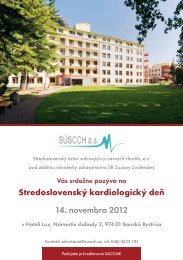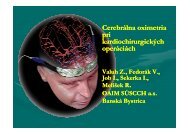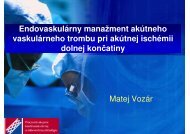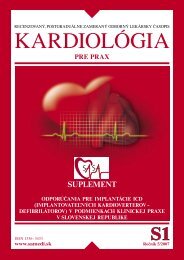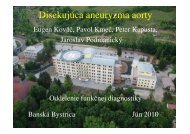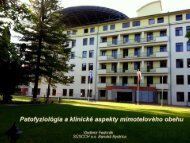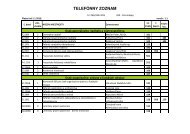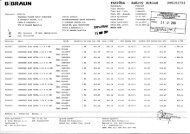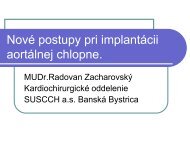Management of acute myocardial infarction in patients presenting ...
Management of acute myocardial infarction in patients presenting ...
Management of acute myocardial infarction in patients presenting ...
You also want an ePaper? Increase the reach of your titles
YUMPU automatically turns print PDFs into web optimized ePapers that Google loves.
ESC Guidel<strong>in</strong>es 2927<br />
Table 17 Intravenous doses <strong>of</strong> recommended antiarrhythmic/antibradycardia medications<br />
Drug Bolus Ma<strong>in</strong>tenance <strong>in</strong>fusion<br />
.............................................................................................................................................................................<br />
Amiodarone 150 mg over 10 m<strong>in</strong>. Supplemental boluses <strong>of</strong> 150 mg may be given over 10–30 m<strong>in</strong> 1 mg/m<strong>in</strong> for 6 h and then 0.5 mg/m<strong>in</strong> may be<br />
for recurrent arrhythmias, but limited to 6–8 supplemental boluses <strong>in</strong> any 24-h necessary after <strong>in</strong>itial bolus dose<br />
period<br />
Esmolol 500 mg/kg over 1 m<strong>in</strong>, followed by 50 mg/kg/m<strong>in</strong> over 4 m<strong>in</strong> 60–200 mg/kg/m<strong>in</strong><br />
Metoprolol 2.5–5 mg over 2 m<strong>in</strong>; up to three doses –<br />
Atenolol 5–10 mg (1 mg/m<strong>in</strong>) –<br />
Propranolol 0.15 mg/kg –<br />
Digox<strong>in</strong> 0.25 mg each 2 h, up to 1.5 mg –<br />
Lidoca<strong>in</strong>e 0.5–0.75 mg/kg –<br />
Sotalol 20–120 mg over 10 m<strong>in</strong> (0.5–1.5 mg/kg). May be repeated after 6 h (maximum –<br />
640 mg/24 h)<br />
Verapamil 0.075–0.15 mg/kg over 2 m<strong>in</strong> –<br />
Diltiazem 0.25 mg/kg over 2 m<strong>in</strong> –<br />
Atrop<strong>in</strong>e Rapid bolus <strong>of</strong> at least 0.5 mg, repeated up to a total dose <strong>of</strong> 1.5–2.0 mg (0.04 mg/kg) –<br />
Isoproterenol 0.05–0.1 mg/kg/m<strong>in</strong>, up to 2 mg/kg/m<strong>in</strong>. Dosage adjusted to heart rate and rhythm –<br />
5. Rout<strong>in</strong>e prophylactic therapies<br />
<strong>in</strong> the <strong>acute</strong> phase<br />
Recommendations are summarized <strong>in</strong> Table 18.<br />
a. Antithrombotic agents: aspir<strong>in</strong>, clopidogrel,<br />
and antithromb<strong>in</strong>s<br />
See reperfusion treatments (Table 5).<br />
b. Antiarrhythmic drugs<br />
Rout<strong>in</strong>e prophylactic use is not justified.<br />
Table 18 Rout<strong>in</strong>e prophylactic therapies <strong>in</strong> the <strong>acute</strong><br />
phase <strong>of</strong> STEMI<br />
Recommendations Class a Level b<br />
................................................................................<br />
Aspir<strong>in</strong>: ma<strong>in</strong>tenance dose <strong>of</strong> 75–100 mg I A<br />
Clopidogrel: ma<strong>in</strong>tenance dose <strong>of</strong> 75 mg I A<br />
Non-selective and selective COX-2 agents III C<br />
I.v. b-blocker IIb A<br />
Oral b-blocker I A<br />
ACE-<strong>in</strong>hibitor: oral formulation on first day<br />
for all <strong>patients</strong> <strong>in</strong> whom it is not contra<strong>in</strong>dicated IIa A<br />
for high-risk <strong>patients</strong> I A<br />
Nitrates IIb A<br />
Calcium antagonists III B<br />
Magnesium III A<br />
Lidoca<strong>in</strong>e III B<br />
Glucose–<strong>in</strong>sul<strong>in</strong>–potassium <strong>in</strong>fusion III B<br />
a Class <strong>of</strong> recommendation.<br />
b Level <strong>of</strong> evidence.<br />
c. b-Blockers<br />
The benefit <strong>of</strong> long-term b-blockers after STEMI is well established<br />
(see below); the role <strong>of</strong> rout<strong>in</strong>e early i.v. adm<strong>in</strong>istration is less<br />
firmly established. Two randomized trials <strong>of</strong> i.v. b-blockade <strong>in</strong><br />
<strong>patients</strong> receiv<strong>in</strong>g fibr<strong>in</strong>olysis 138,139 were too small to allow conclusions<br />
to be drawn. A post hoc analysis <strong>of</strong> the use <strong>of</strong> atenolol<br />
<strong>in</strong> the GUSTO-I trial and a systematic review did not support<br />
the rout<strong>in</strong>e early i.v. use <strong>of</strong> b-blockers. 140,141<br />
In the COMMIT CCS 2 trial, i.v. metoprolol followed by oral<br />
adm<strong>in</strong>istration until discharge or up to 4 weeks <strong>in</strong> 45 852 <strong>patients</strong><br />
with suspected <strong><strong>in</strong>farction</strong> 142 did not improve survival when compared<br />
with placebo. Fewer <strong>patients</strong> had re<strong><strong>in</strong>farction</strong> or VF with<br />
metoprolol, but this was counterbalanced by a significant <strong>in</strong>crease<br />
<strong>in</strong> cardiogenic shock. Early i.v. use <strong>of</strong> b-blockers is clearly contra<strong>in</strong>dicated<br />
<strong>in</strong> <strong>patients</strong> with cl<strong>in</strong>ical signs <strong>of</strong> hypotension or congestive<br />
heart failure. Early use may be associated with a modest benefit <strong>in</strong><br />
low-risk, haemodynamically stable <strong>patients</strong>. In most <strong>patients</strong>,<br />
however, it is prudent to wait for the patient to stabilize before<br />
start<strong>in</strong>g an oral b-blocker.<br />
d. Nitrates<br />
The GISSI-3 143 trial tested a strategy <strong>of</strong> rout<strong>in</strong>e transdermal use <strong>of</strong><br />
nitrates vs. selected adm<strong>in</strong>istration because <strong>of</strong> ongo<strong>in</strong>g ischaemia <strong>in</strong><br />
19 394 <strong>patients</strong>. No significant reduction <strong>in</strong> mortality was observed<br />
with the rout<strong>in</strong>e adm<strong>in</strong>istration. The ISIS-4 trial, 144 <strong>in</strong> which oral<br />
mononitrate was adm<strong>in</strong>istered <strong>acute</strong>ly and cont<strong>in</strong>ued for 1<br />
month, also failed to show a benefit. The rout<strong>in</strong>e use <strong>of</strong> nitrates<br />
<strong>in</strong> the <strong>in</strong>itial phase <strong>of</strong> a STEMI has not been shown conv<strong>in</strong>c<strong>in</strong>gly<br />
to be <strong>of</strong> value and is, therefore, not recommended.<br />
e. Calcium antagonists<br />
A meta-analysis <strong>of</strong> trials <strong>in</strong>volv<strong>in</strong>g calcium antagonists early <strong>in</strong> the<br />
course <strong>of</strong> a STEMI showed a non-significant adverse trend. 145<br />
There is no case for us<strong>in</strong>g calcium antagonists for prophylactic purposes<br />
<strong>in</strong> the <strong>acute</strong> phase.



